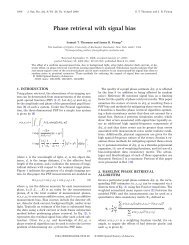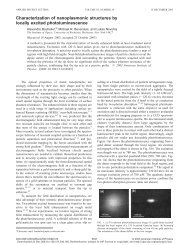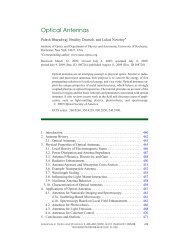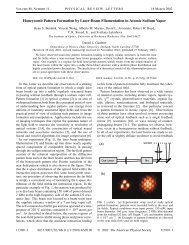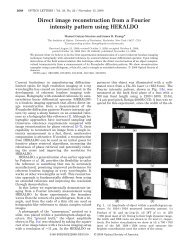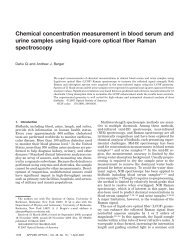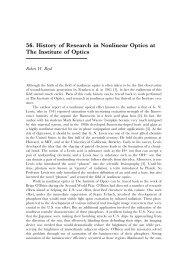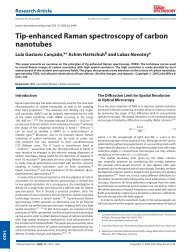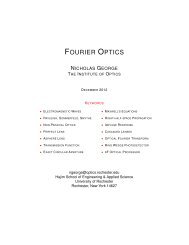Nonlinear Excitation of Surface Plasmon Polaritons by Four-Wave ...
Nonlinear Excitation of Surface Plasmon Polaritons by Four-Wave ...
Nonlinear Excitation of Surface Plasmon Polaritons by Four-Wave ...
Create successful ePaper yourself
Turn your PDF publications into a flip-book with our unique Google optimized e-Paper software.
PRL 101, 056802 (2008)<br />
PHYSICAL REVIEW LETTERS week ending<br />
1 AUGUST 2008<br />
<strong>Nonlinear</strong> <strong>Excitation</strong> <strong>of</strong> <strong>Surface</strong> <strong>Plasmon</strong> <strong>Polaritons</strong> <strong>by</strong> <strong>Four</strong>-<strong>Wave</strong> Mixing<br />
Stefano Palomba and Lukas Novotny*<br />
Institute <strong>of</strong> Optics, University <strong>of</strong> Rochester, Rochester, New York, USA<br />
(Received 4 April 2008; revised manuscript received 17 June 2008; published 1 August 2008)<br />
We demonstrate nonlinear excitation <strong>of</strong> surface plasmons on a gold film <strong>by</strong> optical four-wave mixing.<br />
Two excitation beams <strong>of</strong> frequencies ! 1 and ! 2 are used in a modified Kretschmann configuration to<br />
induce a nonlinear polarization at a frequency <strong>of</strong> ! 4wm 2! 1 ! 2 , which gives rise to surface plasmon<br />
excitation at a frequency <strong>of</strong> ! 4wm . We observe a characteristic plasmon dip at the Kretschmann angle and<br />
explain its origin in terms <strong>of</strong> destructive interference. Despite a nonvanishing bulk response, surface<br />
plasmon excitation <strong>by</strong> four-wave mixing is dominated <strong>by</strong> a nonlinear surface polarization. To interpret<br />
and validate our results, we provide a comparison with second-harmonic generation.<br />
DOI: 10.1103/PhysRevLett.101.056802<br />
The geometry-dependent excitations <strong>of</strong> a strongly<br />
coupled plasma (surface plasmons) give rise to unique<br />
optical properties, which are currently being explored for<br />
various photonic and electronic applications [1–3]. On<br />
planar or cylindrical metal interfaces, the momentum<br />
(wave vector) <strong>of</strong> surface plasmons is larger than the momentum<br />
associated with free propagating electromagnetic<br />
radiation [4,5] making it necessary to excite surface plasmons<br />
with evanescent waves [6–9]. The most widely<br />
employed surface plasmon excitation scheme is the<br />
Kretschmann configuration [8]. In this configuration, surface<br />
plasmon excitation is associated with characteristic<br />
dips in the angular reflectivity <strong>of</strong> a laser beam incident on a<br />
metal film deposited on the surface <strong>of</strong> a prism. <strong>Nonlinear</strong><br />
studies <strong>of</strong> surface plasmon excitation on metal films have<br />
concentrated predominantly on second-order processes,<br />
such as second-harmonic generation (SHG) and sumfrequency<br />
generation [10–12]. The reason for using<br />
second-order processes lies in its simplicity and the ability<br />
to discriminate the bulk response from the surface response<br />
using the inversion symmetry <strong>of</strong> most metals [10,13]. For<br />
third-order processes, it can be expected that the bulk<br />
response strongly dominates over the surface response,<br />
and hence it is not a priori clear how effective third-order<br />
surface plasmon excitation is. In this Letter, we show that,<br />
despite the third-order bulk response, surface plasmons on<br />
metal films can be efficiently excited <strong>by</strong> four-wave mixing<br />
in the Kretschmann configuration. This result holds promise<br />
for applications in nonlinear plasmonics, e.g., surface<br />
plasmon amplification, surface plasmon switching, and<br />
manipulation.<br />
We consider a gold film <strong>of</strong> thickness 52 nm (roughness<br />
1 nm rms, prepared <strong>by</strong> e-beam evaporation on glass)<br />
excited in a modified Kretschmann configuration (cf.<br />
Fig. 1) <strong>by</strong> two incident laser beams <strong>of</strong> frequencies ! 1<br />
and ! 2 , respectively. The metal’s third-order susceptibility<br />
3<br />
gives rise to a nonlinear polarization at frequency<br />
! 4wm 2! 1 ! 2 , which leads to scattered radiation at<br />
the same frequency. The two laser beams are generated <strong>by</strong><br />
a Ti:sapphire laser, providing pulses <strong>of</strong> duration 200 fs<br />
and wavelength 1 810 nm, and an optical parametric<br />
PACS numbers: 73.20.Mf, 42.65.Ky, 78.47.nj<br />
oscillator, providing pulses <strong>of</strong> the same duration and wavelength<br />
2 1162 nm. Both lasers have a repetition rate <strong>of</strong><br />
76 MHz, and the average powers are 3 and 12 mW, respectively.<br />
The spot diameters at the gold surface are 1.2<br />
and 4 m, respectively. The scattered light at the fourwave<br />
mixing frequency ! 4wm has a wavelength <strong>of</strong> 4wm<br />
613 nm.<br />
As shown in Fig. 1, we use an oil-immersion objective <strong>of</strong><br />
numerical aperture NA 1:3 and magnification M 40<br />
to focus the incident laser beams on the metal surface and<br />
to collect the generated light at the four-wave mixing<br />
frequency. The different wavelengths are spectrally separated<br />
<strong>by</strong> optical filters (two bandpass filters 500 nm < <<br />
700 nm, two shortpass filters 725 nm). The angular resolution <strong>of</strong> the experiments is<br />
n<br />
NA<br />
k sp<br />
E 4WM<br />
Gold film<br />
Dichroic<br />
beam splitter<br />
CCD<br />
E 1 E 2<br />
FIG. 1 (color online). <strong>Nonlinear</strong> excitation <strong>of</strong> surface plasmons.<br />
Two incident beams at frequencies ! 1 and ! 2 give rise<br />
to four-wave mixing at a gold film and generate an outgoing<br />
beam at frequency ! 4wm 2! 1 -! 2 , which is projected onto a<br />
CCD. The lateral CCD coordinates correspond to the transverse<br />
wave vector k x .<br />
0031-9007=08=101(5)=056802(4) 056802-1 © 2008 The American Physical Society
PRL 101, 056802 (2008)<br />
PHYSICAL REVIEW LETTERS week ending<br />
1 AUGUST 2008<br />
defined <strong>by</strong> the diameter <strong>of</strong> the incident laser beams relative<br />
to the size <strong>of</strong> the back aperture (13 mm) <strong>of</strong> the objective<br />
lens. The angle <strong>of</strong> emission is measured <strong>by</strong> projecting the<br />
scattered beam at ! 4wm on a thermoelectrically cooled<br />
CCD. Thus, the displacement x <strong>of</strong> the detected spot on<br />
the CCD measured from the optical axis is a direct measure<br />
for the transverse wave vector k x k=f x [14], with f<br />
being the focal length <strong>of</strong> the objective and k n! 4wm =c<br />
being the wave vector <strong>of</strong> the emitted radiation.<br />
The third-order susceptibility 3 giving rise to fourwave<br />
mixing is a tensor <strong>of</strong> rank 3. Although the symmetry<br />
<strong>of</strong> our experimental configuration allows many components<br />
<strong>of</strong> the tensor to be eliminated, the number <strong>of</strong> unknowns<br />
remains high. Furthermore, in addition to the bulk<br />
response, we have to take into consideration the surfacespecific<br />
response. Therefore, to establish an understanding<br />
for the observed third-order response, we relate our observations<br />
to SHG, which is a reasonably well understood<br />
second-order process [10–12]. In fact, for SHG the bulk<br />
response can be greatly ignored, and only two tensor<br />
components <strong>of</strong> the surface susceptibility need to be<br />
considered [10].<br />
Thus, let us first consider SHG <strong>by</strong> two collinear excitation<br />
beams incident at the angle as shown in Fig. 2(a).<br />
The two beams are p-polarized and are incident from glass<br />
d<br />
ε 3<br />
ε 2<br />
ε 1<br />
P<br />
where all quantities are evaluated at the second-harmonic<br />
frequency 2!. The coupling to the surface plasmons propagating<br />
at the top interface is dominated <strong>by</strong> the poles <strong>of</strong> the<br />
r 23 term, i.e., k 2z " 3 k 3z " 2 0. Efficient coupling to<br />
surface plasmons results in strong leakage radiation [18].<br />
However, the latter interferes with the nonlinear field emitted<br />
from the lower interface. This interference is repreθ<br />
P<br />
z<br />
θ<br />
θ<br />
ω<br />
2ω<br />
2ω<br />
FIG. 2 (color online). Illustration <strong>of</strong> nonlinear surface plasmon<br />
excitation <strong>by</strong> SHG. (a) The incident laser field generates nonlinear<br />
surface polarizations at the lower and upper gold interfaces.<br />
(b) The nonlinear polarization P # at the lower interface<br />
acts as a source for a secondary field at the nonlinear frequency<br />
2!. (c) The same holds for the polarization P " at the upper<br />
interface.<br />
(a)<br />
(b)<br />
(c)<br />
2<br />
S<br />
x<br />
x<br />
x<br />
2<br />
S;xzx<br />
(" 1 2:25) onto a gold film <strong>of</strong> thickness d and dielectric<br />
function " 2 ! . It has been demonstrated that the largest<br />
contribution to the nonlinear signal at frequency 2! originates<br />
from a second-order surface susceptibility<br />
[10,15], where the indices indicate field components parallel<br />
(x) and perpendicular (z) to the interface, respectively.<br />
The incident waves are represented as<br />
E ! E 0 k 1z =k 1 n x k x =k 1 n z e ik xx ik 1z z i!t ; (1)<br />
where k 1 k x ; 0;k 1z and k 2 1 " 1 !=c 2 . n x and n z are<br />
unit vectors in the x and z directions, respectively. The<br />
components <strong>of</strong> the k 1 vector are determined <strong>by</strong> the angle <strong>of</strong><br />
incidence according to k x k 1 cos and k 1z k 1 sin .<br />
As illustrated in Figs. 2(b) and 2(c), we consider two interfaces.<br />
The surface polarization at the second-harmonic<br />
frequency on the bottom interface is calculated as<br />
P # x 2! " o<br />
2<br />
S;xzx 2!; !; ! E z ! E x !<br />
2 "<br />
" 1<br />
o S;xzx E2 0<br />
1<br />
" 2<br />
1<br />
r 12 r 23 exp 2ik 2z d<br />
1 r 12 r 23 exp 2ik 2z d<br />
r 12 r 23 exp 2ik 2z d<br />
1 r 12 r 23 exp 2ik 2z d<br />
k x k 1z<br />
k 2 e 2ik xx 2i!t ; (2)<br />
1<br />
where we have used the single-interface Fresnel reflection<br />
and transmission coefficients for p polarization [16].<br />
Notice that both exciting fields (E z and E x ) are evaluated<br />
on the gold side <strong>of</strong> the interface and that all<br />
q<br />
quantities are<br />
evaluated at the frequency !. Also, k 2z k 2 2 k 2 x.<br />
The polarization P # x now acts as a source current at the<br />
second-harmonic frequency, and the resulting field E 2!<br />
is calculated as<br />
E r; 2!<br />
2!=c 2<br />
" o<br />
Zsurface<br />
G $ r; r 0 ;2! P # r 0 ; 2! dr 0 :<br />
(3)<br />
The field radiated into the upper space is reflected from the<br />
top boundary and then superimposed to the field emitted<br />
into the lower space. The total field in the lower half-space<br />
due to the polarization P # x is then calculated to be [17]<br />
E # 2!<br />
P # x k 1 k 2 r 23 t 21 exp 2ik 2z d<br />
2" o " 1 " 2 1 r 12 r 23 exp 2ik 2z d<br />
k 1z =k 1 n x 2 k x =k 1 n z e ik 1zz ; (4)<br />
056802-2
PRL 101, 056802 (2008)<br />
PHYSICAL REVIEW LETTERS week ending<br />
1 AUGUST 2008<br />
sented <strong>by</strong> the two terms in the brackets in Eq. (4) and gives<br />
rise to the observed ‘‘plasmon dip’’ as discussed later.<br />
We now turn to the fields generated <strong>by</strong> the polarization<br />
P " x at the upper interface, as illustrated in Fig. 2(c). We find<br />
P " x 2! " o<br />
2<br />
xzx E 2 0<br />
t 12 1 r 23 exp ik 2z d<br />
1 r 12 r 23 exp 2ik 2z d<br />
t 12 1 r 23 exp ik 2z d<br />
1 r 12 r 23 exp 2ik 2z d<br />
k x k 2z<br />
k 2 e 2ik xx 2i!t :<br />
2<br />
(5)<br />
As in Eq. (2), all quantities are to be evaluated at the<br />
fundamental frequency !. Using P " x as the source current<br />
in Eq. (3), we find for the nonlinear field emitted into the<br />
lower half-space<br />
E " 2!<br />
P " x<br />
2" o<br />
k 2<br />
" 2<br />
t 21 exp ik 2z d<br />
1 r 12 r 23 exp 2ik 2z d<br />
k 1z =k 1 n x 2 k x =k 1 n z e ik 1zz ; (6)<br />
where all quantities are to be evaluated at the nonlinear<br />
frequency 2!. E " has only a single term, and hence plasmon<br />
excitation is observed through leakage radiation, i.e.,<br />
a peak at the Kretschmann angle (calculated for 2!). The<br />
total detected intensity in the lower half-space is calculated<br />
as I ; 2! /jE # E " j 2 and is shown in Fig. 3(a) for an<br />
excitation wavelength <strong>of</strong> 2 c=! 1162 nm. The<br />
two main features in the theoretical curve are a peak at<br />
42 and a dip at 46 . The dip originates from the<br />
interference <strong>of</strong> SH light emitted from the bottom interface<br />
[cf. Fig. 2(b)], as described <strong>by</strong> Eq. (4). The dip is associated<br />
with surface plasmon excitation at a wavelength <strong>of</strong><br />
581 nm. On the other hand, the narrow peak is due to<br />
surface plasmon excitation at a wavelength <strong>of</strong><br />
1156 nm and originates from the r 23 term in Eq. (6).<br />
This peak has been documented before for the case <strong>of</strong> a<br />
silver film [11].<br />
I(2ω) (arb. units)<br />
1<br />
0.5<br />
0<br />
0<br />
(a)<br />
20 40 60 0<br />
θ(deg)<br />
20 40<br />
θ(deg)<br />
FIG. 3 (color online). Second-harmonic generation from a<br />
52 nm gold film on a glass substrate excited at a wavelength<br />
<strong>of</strong> 1162 nm. (a) Theoretical curve revealing a plasmon peak<br />
and a plasmon dip. (b) Experimental curve acquired with the<br />
setup shown in Fig. 1. The inset shows an image <strong>of</strong> the recorded<br />
SH light showing the plasmon dip at 46 .<br />
(b)<br />
60<br />
Figure 3(b) shows our experimental results for the angular<br />
dependence <strong>of</strong> SHG. Besides some bumps due to<br />
laser beam inhomogeneities and surface roughness, the<br />
experimental curve is in good agreement with the predicted<br />
theoretical behavior in Fig. 3(a). Because <strong>of</strong> the finite pixel<br />
size <strong>of</strong> our CCD camera, the experimental angular resolution<br />
is limited to 0:4 and does not allow us to resolve the<br />
narrow plasmon peak at 42 . Instead, the plasmon<br />
peak appears as a smoothed-out bump indicated <strong>by</strong> the<br />
arrow. On the other hand, the plasmon dip at 46 is<br />
clearly resolved and can be identified as originating from<br />
the destructive interference <strong>of</strong> leakage radiation from the<br />
SH surface plasmon and SH radiation emitted from the<br />
bottom interface. The inset in Fig. 3(b) shows a CCD<br />
image for the case where the SH beam overlaps with the<br />
Kretschmann angle. For angles beyond the Kretschmann<br />
angle, the experimental curve starts to deviate from the<br />
2<br />
theoretical one, which is most likely due to zzz, a contribution<br />
that has not been taken into account in our theory<br />
and that increases in strength for large .<br />
Having identified the main mechanisms <strong>of</strong> surface plasmon<br />
excitation <strong>by</strong> second-harmonic generation, we now<br />
discuss our experimental results based on four-wave mixing<br />
(4WM). The nonlinear polarization is determined <strong>by</strong><br />
the input beams as<br />
P ! 4wm 2! 1 ! 2 " o 3 E ! 1 E ! 1 E ! 2 :<br />
(7)<br />
We have three different contributions: the two interfaces<br />
and the bulk. As outlined before, 3 is a tensor <strong>of</strong> rank 3,<br />
and the theoretical analysis will strongly depend on the<br />
tensor elements that are admitted in the model. We avoid<br />
laying out the entire theory as the basic elements are well<br />
conveyed <strong>by</strong> the second-harmonic analysis described<br />
above. Our goal is to demonstrate that, despite the bulk<br />
contribution <strong>of</strong><br />
3 , surface plasmons at the frequency<br />
! 4wm are efficiently excited <strong>by</strong> a nonlinear surface polarization<br />
at the glass-metal interface. Similar to secondharmonic<br />
generation, we expect to observe a characteristic<br />
four-wave mixing dip at the Kretschmann angle generated<br />
<strong>by</strong> destructive interference <strong>of</strong> plasmon leakage radiation<br />
from the top interface and direct radiation from the bottom<br />
interface.<br />
As shown in Fig. 4, we clearly observe the predicted<br />
plasmon dip in the emission patterns. In Figs. 4(a) and 4(b),<br />
we expanded the incident excitation beams in order to<br />
cover a broad range <strong>of</strong> angles . Both incident beams are<br />
p-polarized in Fig. 4(a) and s-polarized in Fig. 4(b).<br />
Evidently, the dip is observed only for p-polarized excitation,<br />
which proves that a surface plasmon is excited at the<br />
four-wave mixing wavelength 4wm 613 nm. For<br />
s-polarized excitation, the 4WM signal is still measurable,<br />
but the dip is not present anymore. The 4WM signal exists<br />
even if the excitation beams are centered on the optical axis<br />
[moved towards the cross-hair in Figs. 4(a) and 4(b)],<br />
056802-3
PRL 101, 056802 (2008)<br />
PHYSICAL REVIEW LETTERS week ending<br />
1 AUGUST 2008<br />
I p / I s<br />
(a)<br />
(b)<br />
2.5<br />
(c)<br />
2.0<br />
1.5<br />
1.0<br />
0.5<br />
0<br />
0<br />
10 20 30 40 50<br />
θ(deg)<br />
60<br />
plasmon dip at the Kretschmann angle indicates that the<br />
dominating nonlinear contribution is a third-order surface<br />
susceptibility. As in the case <strong>of</strong> SHG [cf. Fig. 2(a)], this dip<br />
originates from a nonlinear surface polarization P # x ! 4wm<br />
at the lower gold interface. P # x gives rise to radiation at<br />
frequency ! 4wm emitted into both the lower half-space<br />
(glass substrate) and the metal film. The latter excites<br />
surface plasmons at the upper gold interface, and the<br />
resulting leakage radiation interferes destructively with<br />
the radiation emitted directly into the lower half-space.<br />
This interference is phase-sensitive, and the appearance<br />
<strong>of</strong> a dip requires a clear phase separation between the<br />
two interfering components. No dip would be expected if<br />
the third-order nonlinearity were entirely associated with a<br />
bulk response. We hence conclude that surface plasmon<br />
excitation <strong>by</strong> four-wave mixing is dominated <strong>by</strong> a thirdorder<br />
surface nonlinearity.<br />
We thank Giovanni Piredda for stimulating discussions.<br />
This work was supported <strong>by</strong> the U.S. Department <strong>of</strong><br />
Energy under Grant No. DE-FG02-01ER15204.<br />
FIG. 4 (color online). <strong>Nonlinear</strong> four-wave mixing at a 52 nm<br />
gold film on a glass substrate. (a),(b) CCD images using expanded<br />
excitation beams. (a) p-polarized excitation beams;<br />
(b) s-polarized excitation beams. (c) Angular dependence <strong>of</strong><br />
four-wave mixing radiation ( 4wm 613 nm). The curve shows<br />
the ratio <strong>of</strong> four-wave mixing intensity generated <strong>by</strong> p-polarized<br />
excitation (I p ) and four-wave mixing intensity generated <strong>by</strong><br />
s-polarized excitation (I s ).<br />
which suggests that both bulk and surface nonlinearities<br />
are involved in the four-wave mixing mechanism.<br />
Figure 4(c) plots the normalized 4WM signal over the<br />
entire range <strong>of</strong> incident angles . The graph represents<br />
the ratio <strong>of</strong> four-wave mixing intensity generated <strong>by</strong><br />
p-polarized excitation (I p ) and four-wave mixing intensity<br />
generated <strong>by</strong> s-polarized excitation (I s ). The normalization<br />
is performed in order to remove any possible artifacts due<br />
to diffraction at the rims <strong>of</strong> the backaperture and due to<br />
spectral and angular variations <strong>of</strong> the objective’s transmissivity.<br />
Interestingly, the emitted 4WM radiation is predominantly<br />
p-polarized even if the incident waves are<br />
s-polarized. Additionally, for p-polarized excitation, the<br />
total emitted intensity at ! 4wm is approximately twice as<br />
strong as the intensity generated <strong>by</strong> s-polarized excitation.<br />
These observations indicate that the third-order surface<br />
polarization is a dominant contribution in nonlinear fourwave<br />
mixing at metal films.<br />
In conclusion, we used nonlinear four-wave mixing to<br />
excite surface plasmons on a gold film. A characteristic<br />
*http://www.nano-optics.org<br />
[1] <strong>Surface</strong> <strong>Plasmon</strong> Nanophotonics, edited <strong>by</strong> M. L.<br />
Brongersma and P. G. Kik (Springer, Dordrecht, 2007).<br />
[2] S. A. Maier, <strong>Plasmon</strong>ics: Fundamentals and Applications<br />
(Springer, New York, 2007).<br />
[3] E. Ozbay, Science 311, 189 (2006).<br />
[4] A. Sommerfield, Ann. Phys. Chemie 67, 233 (1899).<br />
[5] J. Zenneck, Ann. Phys. 23, 846 (1907).<br />
[6] E. Devaux, T. W. Ebbesen, J. C. Weeber, and A. Dereux,<br />
Appl. Phys. Lett. 83, 4936 (2003).<br />
[7] B. Hecht et al. Phys. Rev. Lett. 77, 1889 (1996).<br />
[8] E. Kretschmann and H. Raether, Z. Naturforsch. A 23,<br />
2135 (1968).<br />
[9] A. Otto, Z. Phys. 216, 398 (1968).<br />
[10] Y. R. Shen, The Principles <strong>of</strong> <strong>Nonlinear</strong> Optics (Wiley,<br />
New York, 1984).<br />
[11] H. J. Simon, D. E. Mitchell, and J. G. Watson, Phys. Rev.<br />
Lett. 33, 1531 (1974).<br />
[12] H. J. Simon, R. E. Benner, and J. G. Rako, Opt. Commun.<br />
23, 245 (1977).<br />
[13] Y. R. Shen, Nature (London) 337, 519 (1989).<br />
[14] A. Bouhelier et al., Opt. Lett. 32, 2535 (2007).<br />
[15] P. Guyot-Sionnest and Y. R. Shen, Phys. Rev. B 38, 7985<br />
(1988).<br />
[16] M. Born and E. Wolf, Principles <strong>of</strong> Optics (Cambridge<br />
University Press, Cambridge, 1980).<br />
[17] The fields can be derived using the Green’s function in the<br />
form I $ k r 2 rr G o r; r 0 and expressing the scalar<br />
Green’s function G o in terms <strong>of</strong> the Weyl identity.<br />
[18] A. Bouhelier and G. P. Wiederrecht, Opt. Lett. 30, 884<br />
(2005).<br />
056802-4



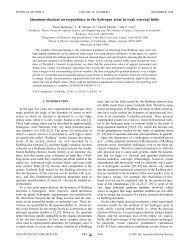
![Phase retrieval algorithms: a personal tour [Invited] - The Institute of ...](https://img.yumpu.com/25023725/1/190x249/phase-retrieval-algorithms-a-personal-tour-invited-the-institute-of-.jpg?quality=85)
